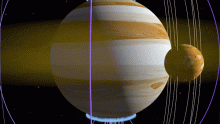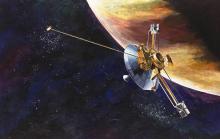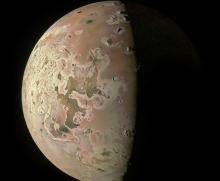Listen to today's episode of StarDate on the web the same day it airs in high-quality streaming audio without any extra ads or announcements. Choose a $8 one-month pass, or listen every day for a year for just $30.
You are here
Moon and Jupiter
Two worlds that are a study in contrasts drop down the western sky early this evening — the Moon and the planet Jupiter. Jupiter is just below the Moon, and looks like a brilliant star.
To the eye alone, the Moon is the biggest, brightest object in the night sky. Compared to Jupiter, though, it’s an astronomical pipsqueak. It’s a ball of rock about 2200 miles in diameter — a bit more than a quarter the size of Earth. It has no atmosphere to speak of, so there’s no weather. And geologically, it’s all but dead, with only an occasional jostle from within.
Jupiter, on the other hand, is the largest body in the solar system other than the Sun — about 40 times the diameter of the Moon. It’s basically a big ball of gas. It’s topped by layers of clouds that are stretched into globe-encircling bands by the planet’s fast rotation.
These clouds form some of the most beautiful and dynamic structures in the solar system — bands and swirls that can look like Impressionist paintings.
And they include the largest storm in the solar system — the Great Red Spot. It’s wider than Earth, and it’s probably been whirling through Jupiter’s atmosphere for more than three centuries. It occasionally swallows other big storms that wander too close, adding their energy to its own — helping sustain this giant storm on a giant planet.
So keep an eye on Jupiter as it drops down the western sky after sunset, not far from the crescent Moon.
Script by Damond Benningfield






